Burger King, a household name in fast food, has a rich history peppered with fascinating tidbits. Did you know that its original name was Insta-Burger King? Or that Sarah Michelle Gellar was involved in a lawsuit with McDonald’s due to a Burger King commercial she starred in as a child? In Australia, the chain goes by the name Hungry Jack’s due to a trademark issue. Even more intriguing is the story of the Whopperito, a burrito version of the iconic Whopper. These and many other fun facts about Burger King reveal a brand that’s constantly evolving and surprising its customers.
1. Original Name

Image: blogger.googleusercontent.com
When Burger King first opened its doors in 1953, it wasn’t known by its current iconic name. Instead, it was called Insta-Burger King. This name was inspired by a unique piece of equipment called the “Insta-Broiler,” which founders Keith J. Kramer and Matthew Burns used to cook their burgers. The Insta-Broiler was revolutionary at the time, allowing the restaurant to produce a high volume of flame-broiled burgers quickly and consistently, setting them apart from other fast-food joints.
The company saw significant changes in 1954 when James McLamore and David Edgerton acquired a franchise in Miami. Realizing the potential for further innovation, they replaced the Insta-Broiler with a gas grill, which became a cornerstone of the restaurant’s cooking method. This change not only improved the flavor of their burgers but also prompted a rebranding. By 1959, the company had dropped the “Insta” from its name, becoming simply Burger King. This name change signaled the beginning of its transformation into a global fast-food powerhouse.
2. First Whopper
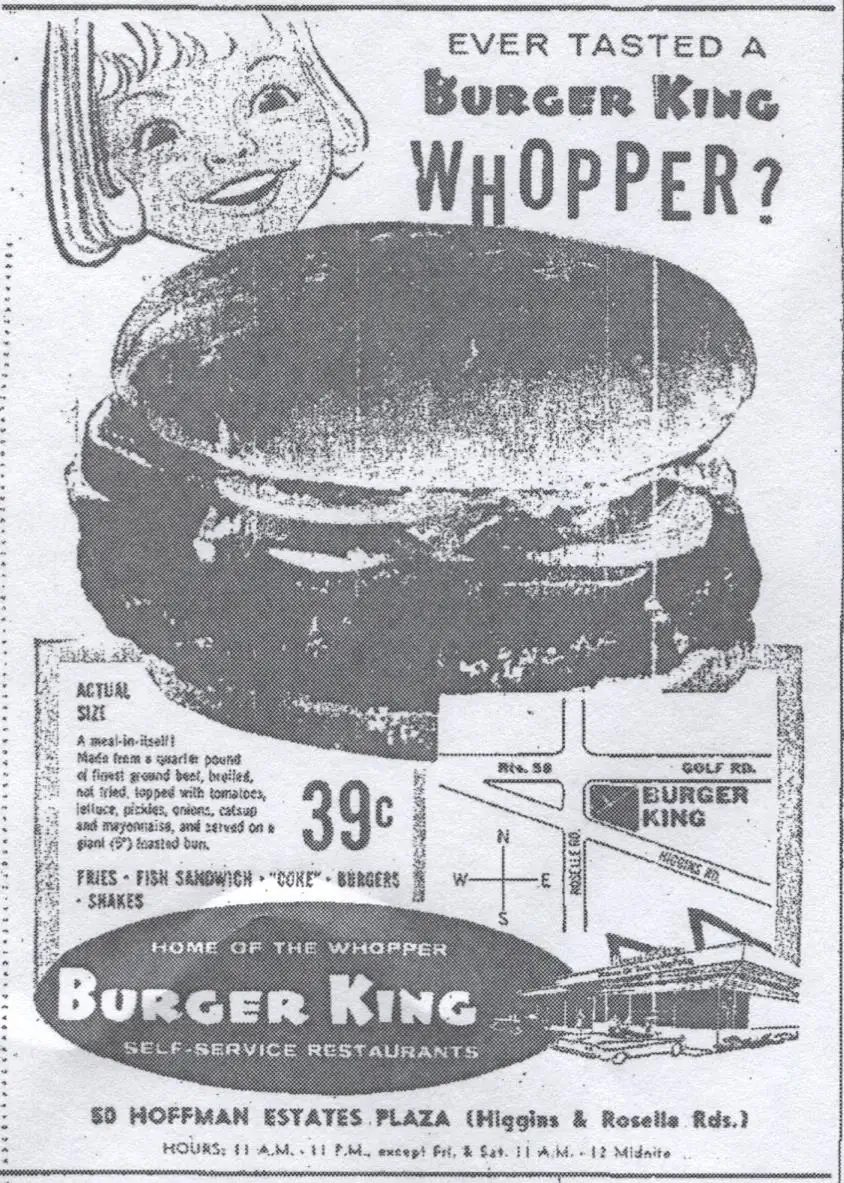
Image: ourlocalhistory.wordpress.com
In 1957, Burger King introduced the Whopper, a now-iconic burger that originally cost just 37 cents. Co-founder Jim McLamore created the Whopper to compete with other fast-food chains that were offering larger burgers.
McLamore believed that a bigger burger would appeal to customers looking for a substantial meal. He named it the “Whopper” to convey the image of something large and impressive. The introduction of the Whopper significantly boosted Burger King’s popularity and established it as a major player in the fast-food industry.
3. Australia’s Hungry Jack’s
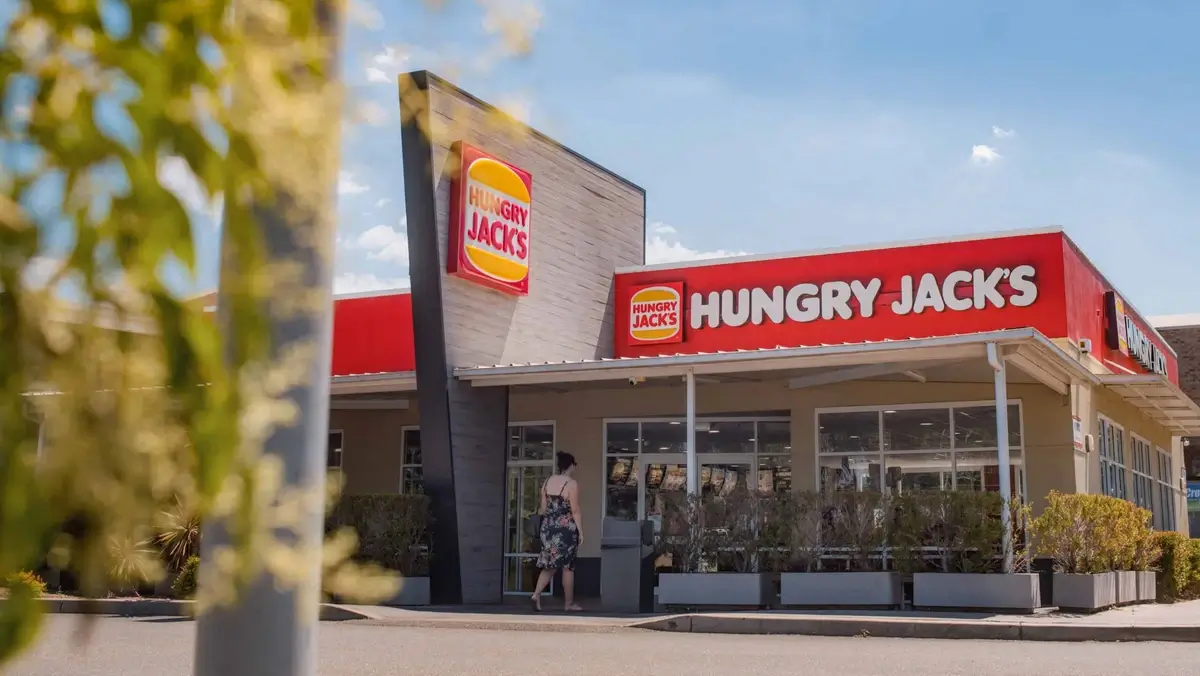
Image: wolfoffranchises.com
In Australia, Burger King operates under the name Hungry Jack’s due to a trademark issue. When Burger King decided to expand to Australia in 1971, they discovered that the name “Burger King” was already registered by a small restaurant in Adelaide. Unable to use their own name, Burger King’s Australian franchisee, Jack Cowin, was given a list of possible names by the parent company. He chose “Hungry Jack’s,” inspired by the company’s pancake mix brand, Hungry Jack, and his own name.
Hungry Jack’s opened its first store in Perth in 1971 and has since become a popular fast-food chain across Australia. Despite the original Burger King trademark expiring in 1991, Cowin successfully argued to retain the Hungry Jack’s brand due to its established popularity. Today, Hungry Jack’s operates over 440 stores in Australia, maintaining a menu similar to Burger King’s but with unique local variations.
4. Creepy Mascot

In 2004, Burger King reintroduced its mascot, “The King,” with a striking and surreal appearance that became known for its unsettling vibe. Unlike the original animated character from the 1970s, the revamped King was portrayed by an actor wearing a comically oversized, static-faced headpiece. This live-action version first appeared in a commercial where The King is seen offering breakfast in a rather creepy manner, setting the tone for his new image.
The mascot’s eerie presence was intentional, designed to grab attention and create memorable ads. However, not everyone appreciated this approach. The King was retired in 2011 after feedback suggested that the mascot’s unsettling look was scaring away some customers, particularly women and children. Despite the retirement, the character left a lasting impact on Burger King’s brand identity and advertising strategies.
5. Whopper Sacrifice Campaign
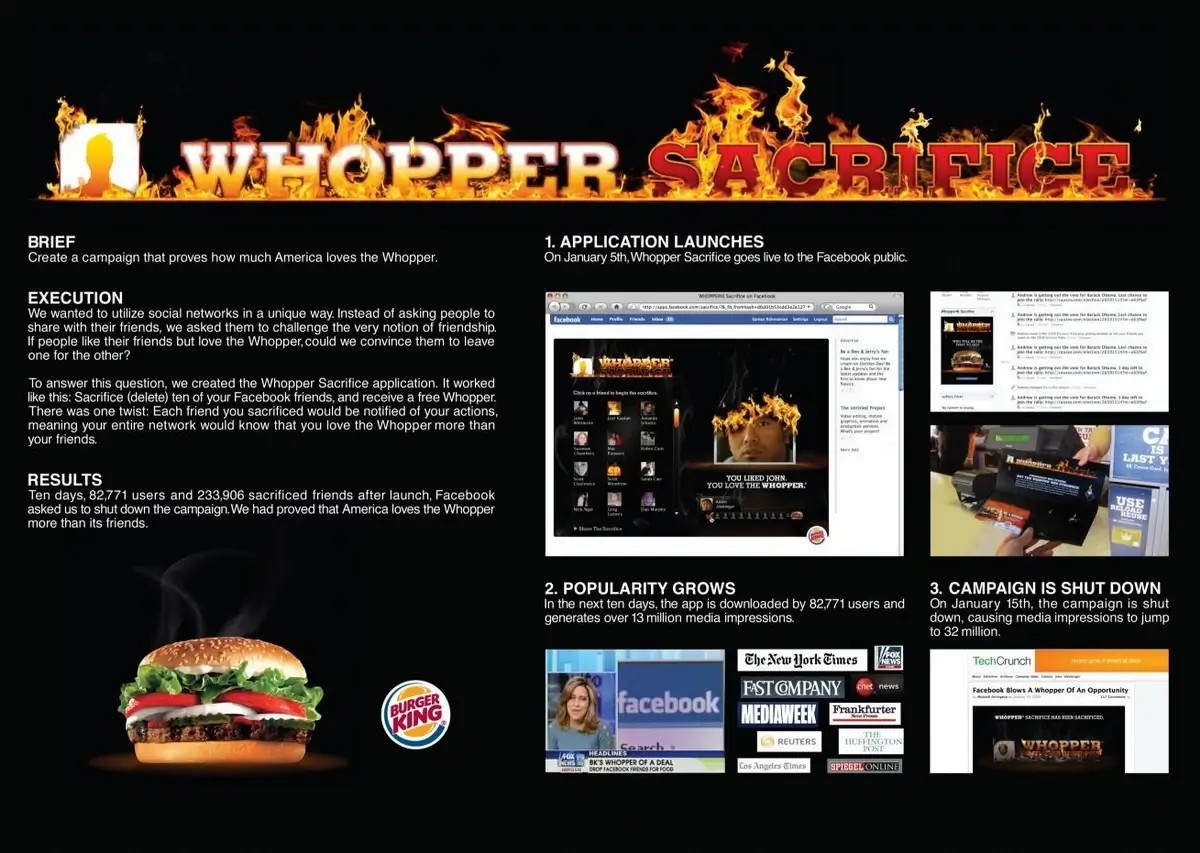
Image: activationideas.com
In 2009, Burger King launched the provocative “Whopper Sacrifice” campaign, which offered a free Whopper to users who deleted ten Facebook friends. The campaign was designed to highlight the value of a Whopper by humorously suggesting it was worth more than online friendships. Users who participated received a notification stating, “You are worth less than one-tenth of a Whopper,” leading to the campaign’s notoriety.
The campaign quickly gained traction, with 233,906 friendships sacrificed and nearly 82,000 Whopper coupons issued. However, Facebook shut it down within ten days, citing violations of user privacy. The app’s straightforward message—sacrifice ten friends for a Whopper—was both its strength and its downfall, sparking widespread discussion about the nature of online relationships and the value placed on social media connections.
6. Burger King Foot Lettuce

Image: cleveland.com
In 2012, a scandal erupted when a photo of a Burger King employee standing in lettuce trays went viral. The image, first posted on the anonymous message board 4chan, was captioned “This is the lettuce you eat at Burger King.”
Within minutes, users tracked down the location of the restaurant using geo-tagging data from the photo. The employee and those involved were promptly fired by Burger King, which issued a statement condemning the incident and reassuring customers about their food safety protocols. This incident highlighted the power of social media in holding businesses accountable.
7. Sarah Michelle Gellar Lawsuit
In 1981, a young Sarah Michelle Gellar starred in a Burger King commercial that sparked a major legal battle between Burger King and McDonald’s. At just five years old, Gellar became the first person to mention a competitor’s name in a commercial, declaring that McDonald’s burgers had 20% less meat than Burger King’s. This bold claim led McDonald’s to sue Burger King, the advertising agency, and Gellar herself.
The lawsuit had a significant impact on Gellar’s childhood. She recalled in interviews that the legal issues led to her being banned from eating at McDonald’s, which was particularly tough during her school years when friends often celebrated birthdays at the fast-food chain. Despite this, Gellar looks back at the incident with humor, noting that her role in the commercial taught her early on about the intricacies of the advertising industry, including the use of non-edible props to make food look appealing on screen.
8. Whopper Wedding

Image: today.com
In 2015, Burger King sponsored a wedding for Joel Burger and Ashley King, who coincidentally shared the names of the famous fast-food chain. The company reached out to the couple after learning about their engagement through a local newspaper, offering to cover the wedding expenses as a unique promotional stunt.
The event, dubbed the “Whopper Wedding,” took place in Jacksonville, Illinois, on July 17, 2015. Burger King provided personalized items and a fun, themed atmosphere for the couple’s special day.
9. Flame-Grilled Since 1954
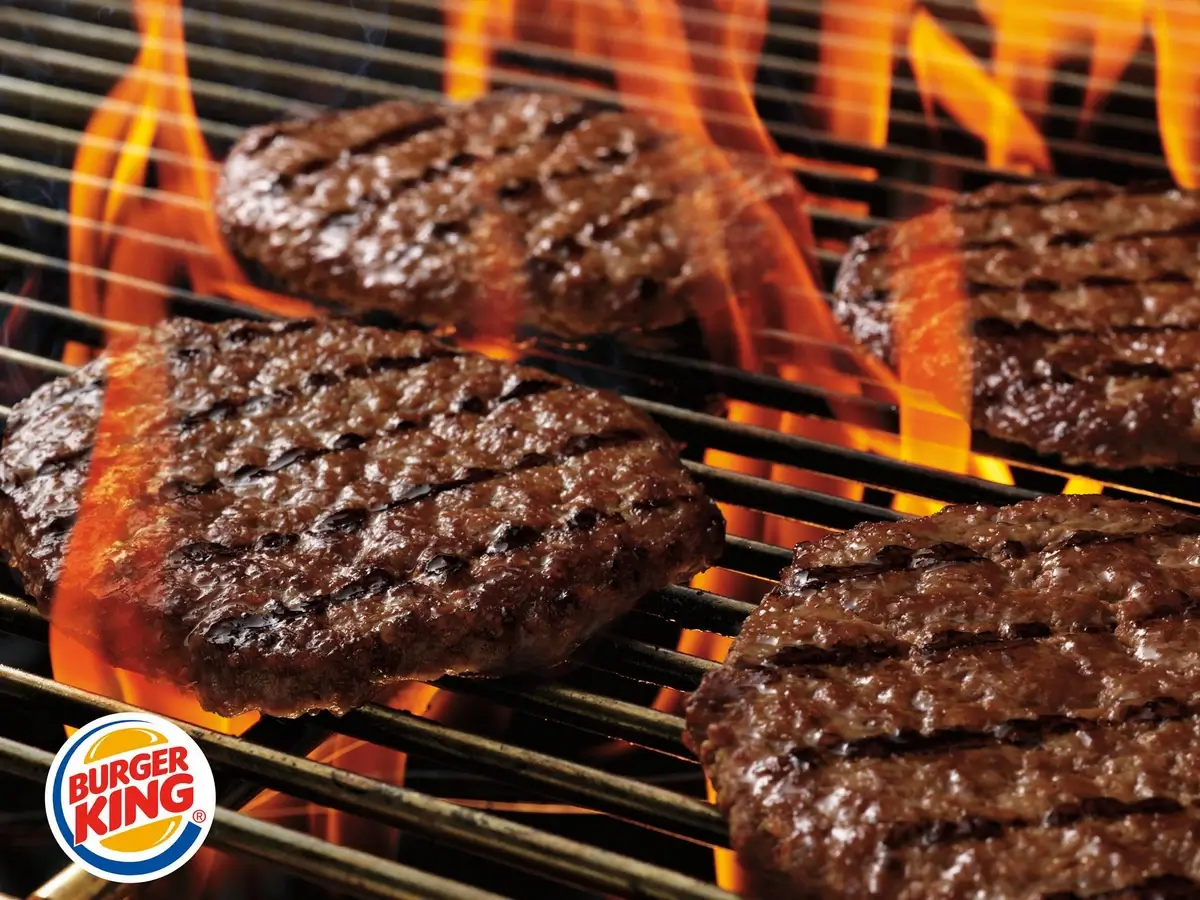
Image: Burger King Sri Lanka / facebook.com
Burger King has been flame-grilling its burgers since the company’s inception in 1954. This unique cooking method involves grilling the patties over an open flame, which imparts a distinctive smoky flavor and creates a charred, caramelized exterior.
This technique not only enhances the taste but also helps in retaining the natural juices of the meat, resulting in a juicy and flavorful burger. Over the decades, flame-grilling has become a signature aspect of Burger King’s brand identity.
10. Burger King’s Crown Card
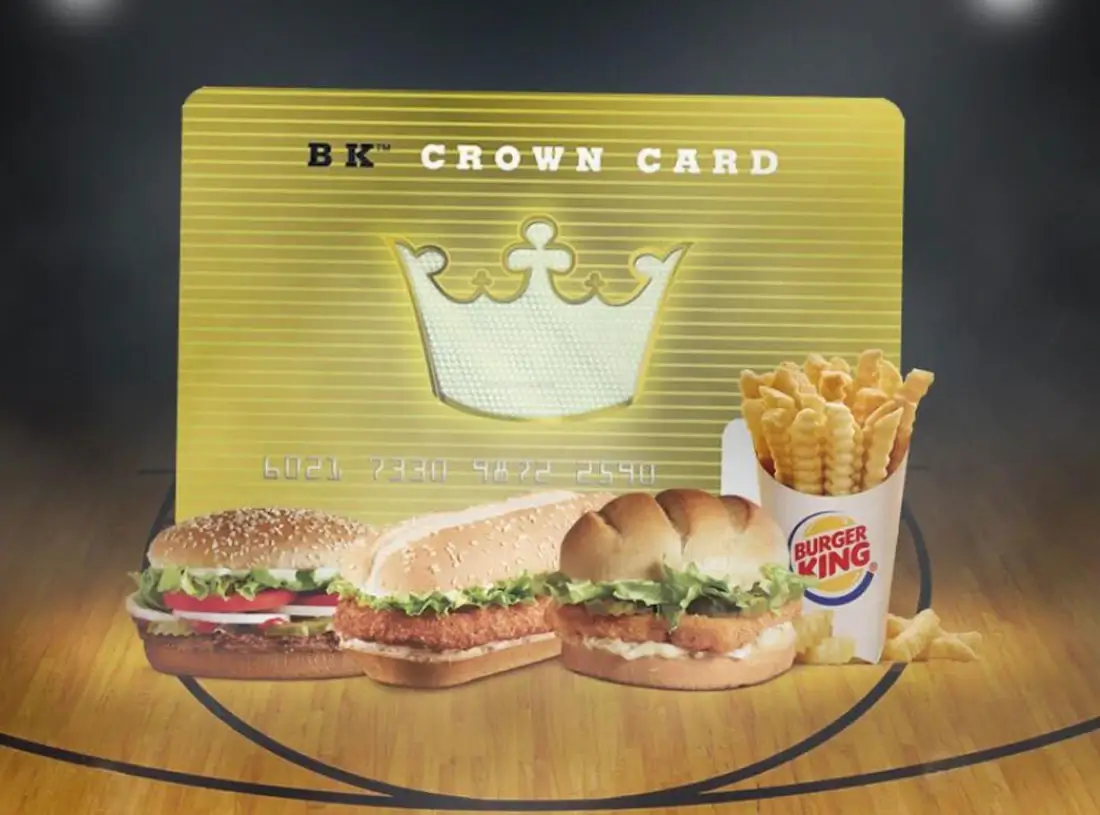
Image: cameocafe.com
Burger King’s Crown Card is a rare and exclusive perk that grants celebrities unlimited free meals at the fast-food chain. Introduced as a way to reward high-profile customers and those with a special relationship with the brand, the Crown Card offers its holders lifetime access to Burger King’s menu. This elite card is highly coveted, but only a handful of celebrities have received it. Among the fortunate recipients are Jennifer Hudson, who worked at Burger King before her rise to fame, and George Lucas, recognized for his promotional partnerships with the chain during the “Star Wars” era.
The card isn’t just a symbol of status but also a functional gift. It can hold up to $500, allowing users to pay for their meals without carrying cash. Additionally, the Crown Card can be used for online orders through the Burger King app or website, providing a seamless dining experience.
11. 40 Billion Cookies
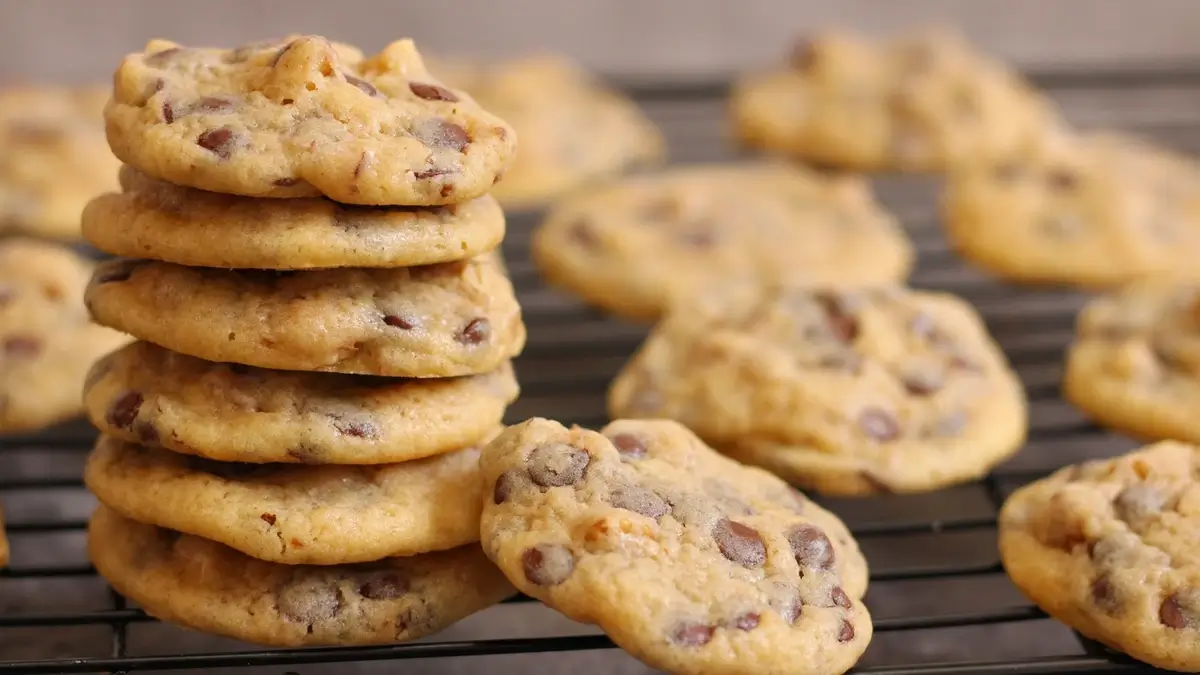
Image: mashed.com
In the fast-food industry, Burger King stands out not just for its flame-grilled burgers but also for its impressive cookie sales. Annually, Burger King is estimated to sell around 40 billion cookies globally.
This staggering figure highlights the popularity of their dessert offerings, which include a variety of cookies that complement their main menu items.
12. Global Presence
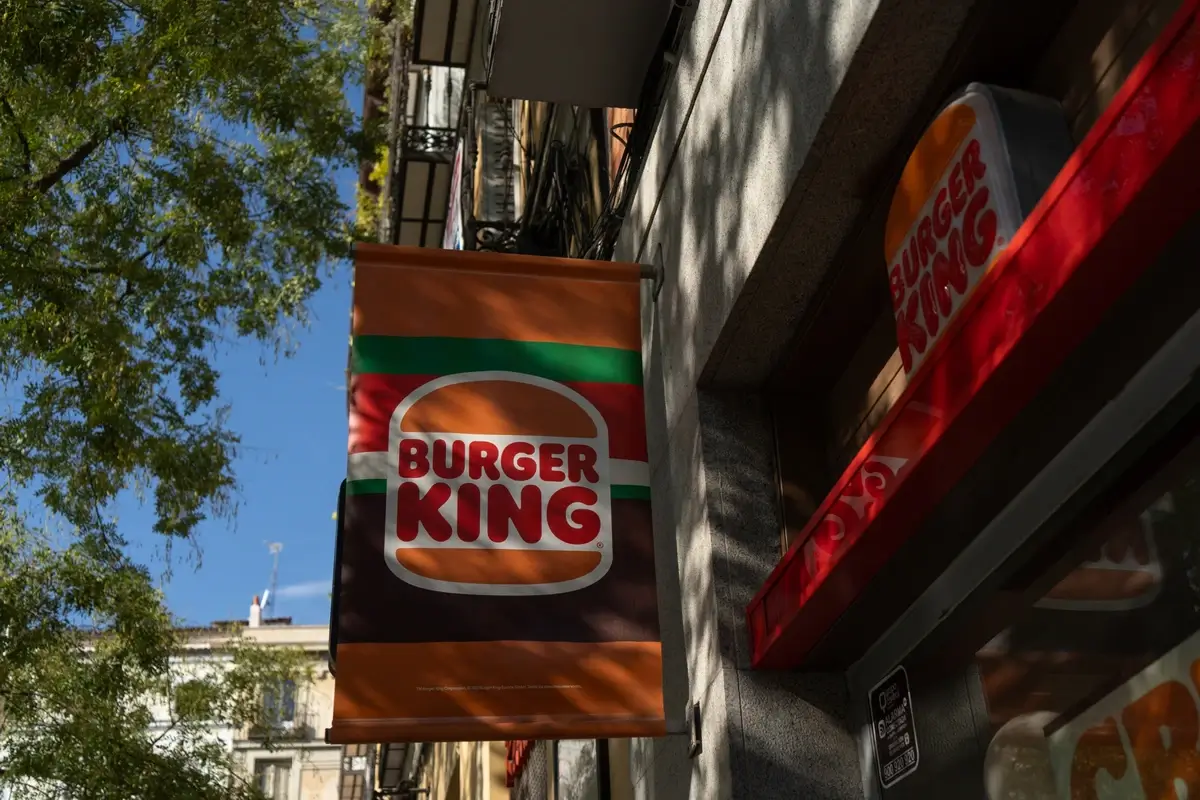
Image: bloomberg.com
As of 2024, Burger King boasts a formidable global presence with over 18,700 locations spread across more than 100 countries. This extensive network highlights the brand’s ability to adapt its menu and marketing strategies to diverse cultures and tastes worldwide.
The first international Burger King opened in Puerto Rico in 1963, marking the beginning of its global expansion. Since then, the chain has seen significant growth in markets like Europe, Asia, and Latin America. Notably, Burger King has tailored its menu to include local favorites alongside its iconic Whopper to cater to regional preferences.
13. Mattoon Burger King

The Original Burger King, Mattoon, Illinois, 1968. Image: Angela / Flickr
In the small town of Mattoon, Illinois, a local restaurant holds the exclusive right to the name “Burger King” within a 20-mile radius. This peculiar situation arose from a trademark dispute in the 1960s. The original Burger King in Mattoon, a mom-and-pop establishment, opened in 1952, predating the national Burger King chain by a year.
When the national chain expanded into Illinois, a legal battle ensued. In 1968, the court ruled in favor of the Mattoon restaurant, allowing them to retain exclusive use of the Burger King name in their immediate area. This decision has led to a unique coexistence: while the national chain operates under the well-known name everywhere else, it must respect the local trademark rights of the Mattoon eatery.
14. Burger King’s Parent Company – Restaurant Brands International
Burger King is owned by Restaurant Brands International (RBI), a Canadian-based multinational company formed in 2014 through the merger of Burger King and Tim Hortons. RBI is one of the world’s largest quick-service restaurant companies, operating over 30,000 restaurants across more than 100 countries. The company also owns other notable brands, including Popeyes and Firehouse Subs.
RBI’s strategy focuses on global expansion, enhancing customer experiences, and implementing sustainable practices to improve food quality and environmental impact.
15. Whopper Jr. Creation
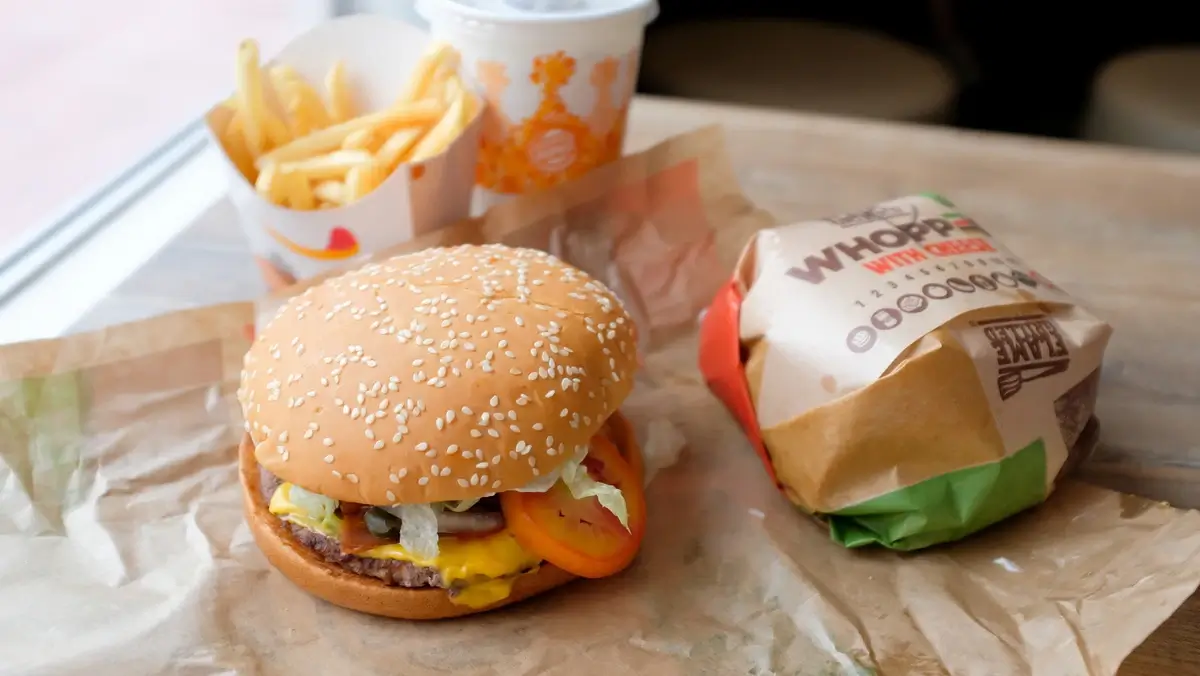
Image: thedailymeal.com
The Whopper Jr. was born out of necessity in 1963 when Burger King opened its first location in Puerto Rico. Luis Arenas-Pérez, the president of Caribbean Restaurants overseeing Burger King’s operations in Puerto Rico, faced a challenge: the molds for the classic Whopper buns hadn’t arrived in time for the restaurant’s opening. Thinking quickly, Arenas-Pérez used smaller, locally sourced buns to create a smaller version of the Whopper.
This innovative solution led to the creation of the Whopper Jr., which quickly gained popularity and was subsequently adopted worldwide.
16. Whopper Perfume
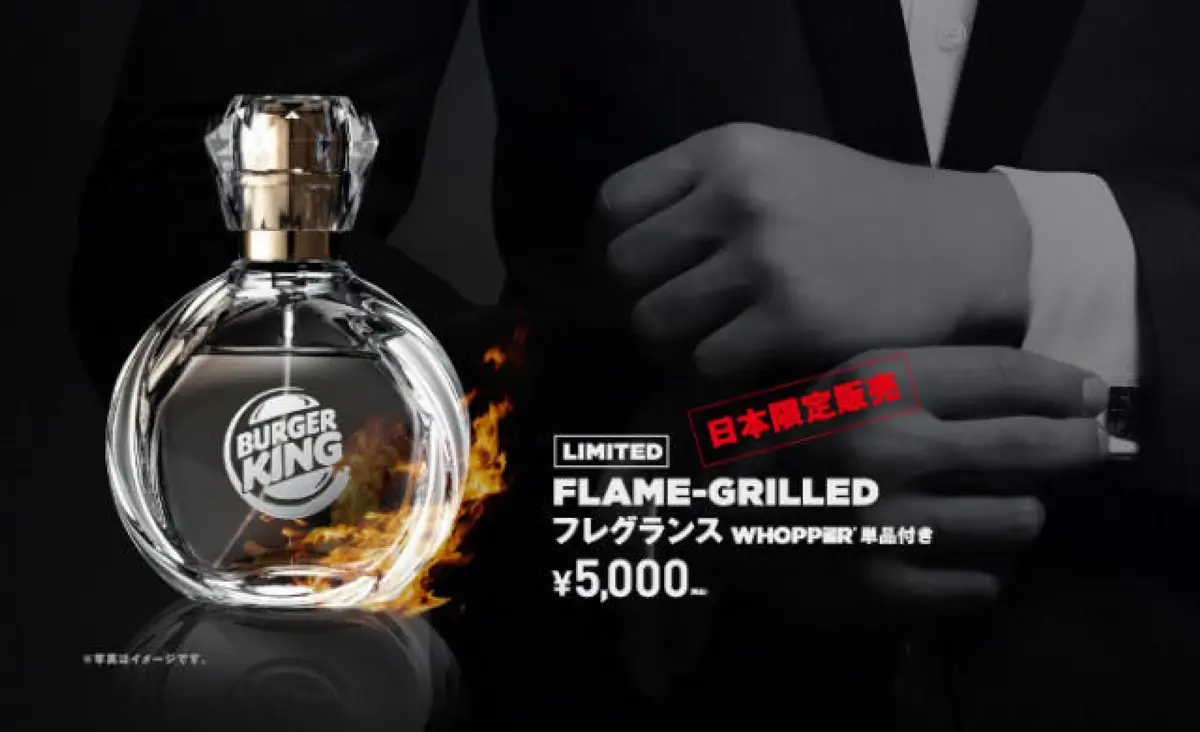
Image: connery.dk
In a bold marketing move, Burger King Japan introduced a limited-edition Whopper-scented perfume on April 1, 2015. Dubbed “Flame-Grilled,” the fragrance aimed to capture the essence of the iconic Whopper burger. This unique product was released as an April Fool’s Day special, available for one day only, and came with a free Whopper.
Priced at ¥5,000 (approximately $40), the promotion quickly gained attention both in Japan and internationally for its quirky and unconventional approach. The perfume sold out rapidly, showcasing Burger King’s knack for innovative and memorable marketing strategies.
17. Herb the Nerd Campaign
In 1985, Burger King launched the “Herb the Nerd” campaign, a $40 million marketing effort to compete with McDonald’s and Wendy’s. The campaign featured Herb, a fictional character who had never eaten a Whopper. The mystery of Herb’s identity was initially teased through cryptic ads in newspapers and on TV. Herb’s identity was revealed during Super Bowl XX in January 1986, where he was portrayed by actor Jon Menick. The campaign offered a $5,000 reward for spotting Herb at a Burger King and a $1 million grand prize.
The promotion included an “I’m not Herb” discount, where customers could get a Whopper for 99 cents by declaring they were not Herb. Despite some initial success, the campaign ultimately failed, with Burger King’s profits falling by 40% in 1986. The campaign ended after three months, and Burger King dropped their advertising agency, J. Walter Thompson, due to the campaign’s poor reception.
18. Whopper Donuts
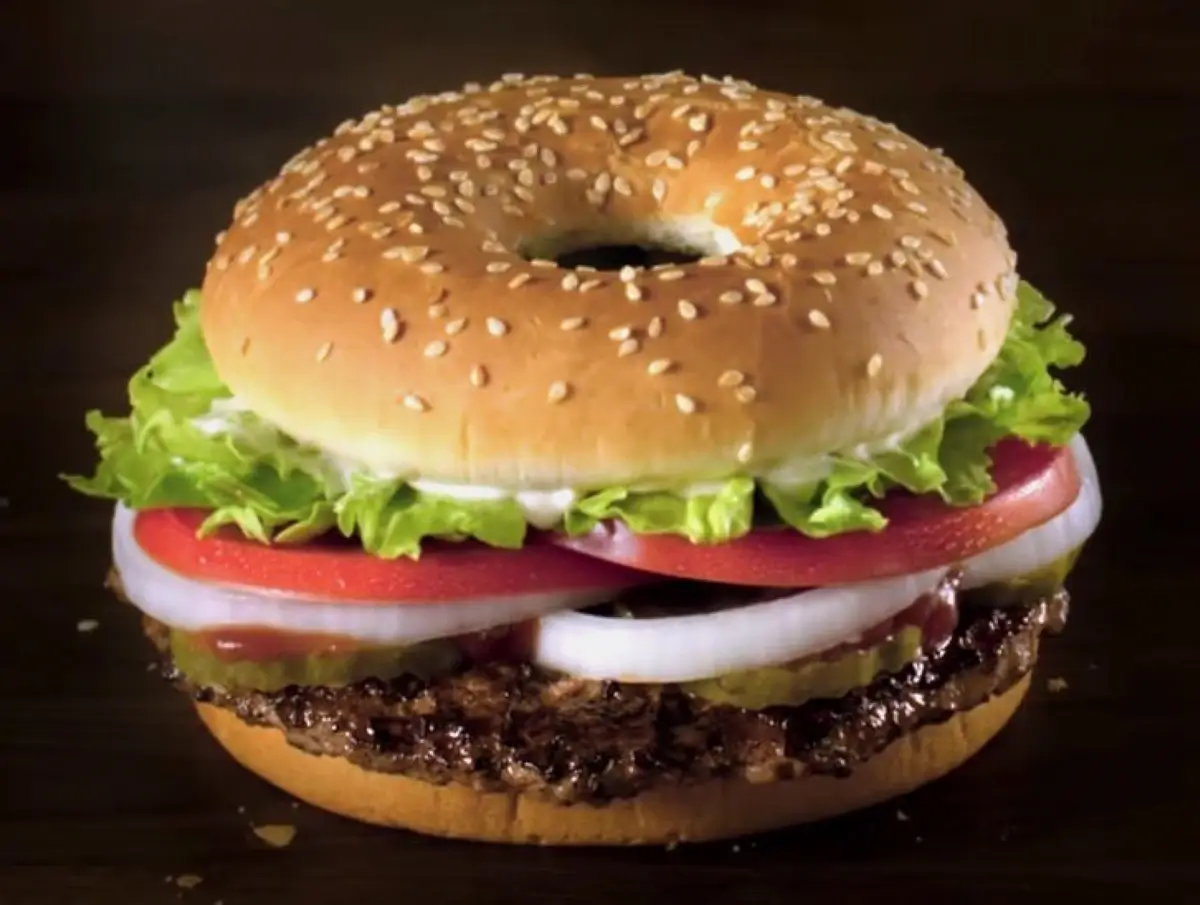
Image: mmm.dk
In celebration of National Doughnut Day in 2018, Burger King introduced the Whopper Donut, a playful twist on their classic Whopper. This limited-edition item featured a traditional Whopper with a hole cut out from the middle, mimicking the shape of a doughnut. The removed “donut hole” was served as a mini slider on the side.
Available at select locations, the Whopper Donut was part of Burger King’s ongoing strategy to engage customers with quirky, attention-grabbing promotions.
19. International Marketing Campaigns
Burger King is renowned for its creative international marketing campaigns. One notable example is the 2017 “Scary Clown Night” campaign, where Burger King offered free Whoppers to customers dressed as clowns on Halloween. This stunt took a playful jab at McDonald’s iconic Ronald McDonald character, capitalizing on the popularity of the horror film It and the creepy clown sightings trend. The promotion was held in select U.S. cities, including Miami, Boston, Los Angeles, Austin, and Salt Lake City.
Another inventive campaign was Burger King’s “Whopper Detour,” where customers who ordered a Whopper through the BK app within 600 feet of a McDonald’s received the burger for just one cent. This campaign, which ran in 2018, not only boosted app downloads but also cleverly diverted traffic from its biggest competitor.
Burger King’s willingness to take bold risks and engage directly with its competitors has helped the brand stand out in the fast-food industry, creating memorable and effective marketing strategies.
20. The Black Whopper

Image: Mike Mozart / Flickr
In 2015, Burger King launched a Halloween special featuring the Black Whopper, a distinctive burger with a black bun. The unique color was achieved using A.1. Steak Sauce, giving the bun a bold, savory flavor. This limited-time offering aimed to capitalize on the Halloween season and attract curious customers with its spooky appearance. However, the burger’s reception was mixed.
While many were intrigued by its look and taste, a significant side effect quickly became a major issue. Consumers reported that the black dye used in the bun caused their stool to turn green, leading to the hashtag #greenpoop trending on social media. Despite reassurances from health professionals that the color change was harmless, the negative publicity overshadowed the initial excitement. The Halloween Whopper ultimately failed to become a recurring seasonal favorite due to these unintended consequences.
FAQ
What was Burger King known for?
Burger King is known for its flame-grilled hamburgers, particularly the Whopper, which has been its signature product since 1957. The chain is also recognized for its unique cooking method, which involves grilling burgers over an open flame to give them a distinctive, smoky flavor.
Why is it called a Whopper?
The Whopper was named to convey its size and quality. When introduced in 1957, the burger was larger than its competitors’ offerings, making it a “whopper” of a sandwich. The name was chosen to signify a substantial, hearty meal.
What is Burger King most famous item?
Burger King’s most famous item is the Whopper. This iconic burger features a flame-grilled beef patty, lettuce, tomato, mayonnaise, ketchup, pickles, and onions on a sesame seed bun. It has become a symbol of the brand and is widely recognized around the world.
What is the Burger King mascot?
The Burger King mascot is “The King.” Known for his oversized, smiling head and royal attire, The King has been a central figure in the company’s advertising campaigns, often appearing in humorous and quirky commercials.
What is the Burger King slogan?
Burger King’s slogan is “Have it your way.” This slogan emphasizes the company’s commitment to providing customers with customizable options and a dining experience tailored to their preferences.





